Effect of High-Temperature Deformation Twinning on the Work Hardening Behavior of Fe-38Mn Alloy during Hot Shear-Compression Deformation
Abstract
:1. Introduction
2. Experimental Section
3. Results
3.1. Flow Behavior
3.2. Microstructural Characteristics
4. Discussion
4.1. Influence of Dynamic Microstructural Evolution
4.2. Work Hardening Behavior
5. Conclusions
- 1.
- The equivalent stress vs. equivalent strain curves for HSCD of Fe-38Mn alloy exhibit the characteristics of continuous work hardening. HSCD constitutes uniform shear-compression deformation with no significant strain localization, and it is mainly concentrated in the gage region of the SCS. However, the shear action in HSCD gradually increases with the increase in strain rate.
- 2.
- The dynamic microstructural evolution is a cDRX in nature, pioneered by the “bulged” mechanism and accompanied by geometric characteristics and sub-grain migration characteristics. The combined deformation, especially shear deformation in the late stage of deformation, accelerates the formation of micro-shear bands, deformation twins and, particularly, interactions between twins and dislocations.
- 3.
- During HSCD, the work hardening rate curve is classified into five stages. High-temperature deformation twinning increases the work hardening rate, and an increasing strain rate is beneficial to twinning behavior and promotes work hardening.
Author Contributions
Funding
Institutional Review Board Statement
Informed Consent Statement
Data Availability Statement
Conflicts of Interest
Nomenclature
| DRV | dynamic recovery |
| DRX | dynamic recrystallization |
| FCC | face-centered cubic |
| SFE | stacking fault energy |
| HSCD | hot shear-compression deformation |
| OM | optical microscopy |
| SEM | scanning electron microscope |
| EBSD | electron backscattered diffraction |
| TEM | transmission electron microscopy |
| LAGBs | low angle grain boundaries |
| HAGBs | high angle grain boundaries |
| TBs | twin boundaries |
| GOS | grain orientation spread |
| cDRX | continuous DRX |
References
- Mecking, H.; Kocks, U. Kinetics of flow and strain-hardening. Acta Met. 1981, 29, 1865–1875. [Google Scholar] [CrossRef]
- Lee, E.U.; Kranzlein, H.H.; Underwood, E.E. Dynamic recovery in aluminum. Mater. Sci. Eng. 1971, 7, 348–356. [Google Scholar] [CrossRef]
- Belyakov, A.; Miura, H.; Sakai, T. Dynamic recrystallization in ultra fine-grained 304 stainless steel. Scr. Mater. 2000, 43, 21–26. [Google Scholar] [CrossRef]
- Wang, Y.; Shao, W.Z.; Zhen, L.; Yang, L.; Zhang, X.M. Flow behavior and microstructures of superalloy 718 during high temperature deformation. Mater. Sci. Eng. A 2008, 497, 479–486. [Google Scholar] [CrossRef]
- Xiong, W.; Wietbrock, B.; Saeed-Akbari, A.; Bambach, M.; Hirt, G. Modeling the Flow Behavior of a High-Manganese Steel Fe-Mn23-C0.6 in Consideration of Dynamic Recrystallization. Steel Res. Int. 2011, 82, 127–136. [Google Scholar] [CrossRef]
- Mishra, B.; Sarkar, R.; Singh, V.; Kumar, D.; Mukhopadhyay, A.; Madhu, V.; Prasad, M.J.N.V. Effect of cold rolling and subsequent heat treatment on microstructural evolution and mechanical properties of Fe-Mn-Al-C-(Ni) based austenitic low-density steels. Mater. Sci. Eng. A 2022, 861, 144324. [Google Scholar] [CrossRef]
- Estrin, Y.; Tóth, L.; Molinari, A.; Bréchet, Y. A dislocation-based model for all hardening stages in large strain deformation. Acta Mater. 1998, 46, 5509–5522. [Google Scholar] [CrossRef]
- Gottstein, G.; Frommert, M.; Goerdeler, M.; Schäfer, N. Prediction of the critical conditions for dynamic recrystallization in the austenitic steel 800H. Mater. Sci. Eng. A 2004, 387, 604–608. [Google Scholar] [CrossRef]
- Xu, S.G.; He, J.S.; Zhang, R.Z.; Zhang, F.Z.; Wang, X.T. Hot deformation behaviors and dynamic softening mechanisms of 7Mo super-austenitic stainless steel with high stacking fault energy. J. Mater. Res. Techn. 2023, 23, 1738–1752. [Google Scholar] [CrossRef]
- Ookawa, A. On the mechanism of deformation twin in fcc crystal. J. Phys. Soc. Jpn. 1957, 12, 825. [Google Scholar] [CrossRef]
- Mahajan, S.; Chin, G.Y. Formation of deformation twins in f.c.c. crystals. Acta Met. 1973, 21, 1353–1363. [Google Scholar] [CrossRef]
- Mori, T.; Fujita, H. Dislocation reactions during deformation twinning in Cu-11 at.% Al single crystals. Acta Met. 1980, 28, 771–776. [Google Scholar] [CrossRef]
- Wang, S.; Jozaghi, T.; Karaman, I.; Arroyave, R.; Chumlyakov, Y.I. Hierarchical evolution and thermal stability of microstructure with deformation twins in 316 stainless steel. Mater. Sci. Eng. A 2017, 694, 121–131. [Google Scholar] [CrossRef]
- Allain, S.; Chateau, J.-P.; Dahmoun, D.; Bouaziz, O. Modeling of mechanical twinning in a high manganese content austenitic steel. Mater. Sci. Eng. A 2004, 387–389, 272–276. [Google Scholar] [CrossRef]
- Ma, E.; Wang, Y.M.; Lu, Q.H.; Sui, M.L.; Lu, L.; Lu, K. Strain hardening and large tensile elongation in ultrahigh-strength nano-twinned copper. Appl. Phys. Lett. 2005, 85, 4932–4934. [Google Scholar] [CrossRef]
- Zhang, J.Q.; Di, H.S.; Wang, X.Y. Flow softening of 253 MA austenitic stainless steel during hot compression at higher strain rates, Mater. Sci. Eng. A 2016, 650, 483–491. [Google Scholar] [CrossRef]
- Sabzi, H.E.; Li, X.H.; Zhang, C.; Fu, H.W.; Rivera-Díaz-del-Castillo Pedro, E.J. Strain hardening in twinning-induced plasticity stainless steel produced by laser powder bed fusion. Mater. Sci. Eng. A 2022, 855, 143882. [Google Scholar] [CrossRef]
- Wang, L.; Xi, Y.T.; Wang, S.Q.; Gao, Q. Microstructure and twinning behavior of TWIP steel deformed by ECAP at warm temperature. Mater. Rev. A 2018, 31, 432–438. [Google Scholar]
- Liu, J.A.; Zhang, W.H.; Mei, F.Q.; Xin, X.; Cao, Y.; Zhu, C.; Liu, Q.; Zhu, X.; Sun, W. Microstructure evolution and work hardening behaviour during cold deformation of Haynes 214 superalloy. J. Mater. Res. Techn. 2023, 24, 5792–5804. [Google Scholar] [CrossRef]
- Lindroos, M.; Cailletaud, G.; Laukkanen, A.; Kuokkala, V.-T. Crystal plasticity modeling and characterization of the deformation twinning and strain hardening in Hadfield steels. Mater. Sci. Eng. A 2018, 720, 145–159. [Google Scholar] [CrossRef]
- Asgari, S.; El-Danaf, E.; Kalidindi, S.R.; Doherty, R.D. Strain hardening regimes and microstructural evolution during large strain compression of low stacking fault energy fcc alloys that form deformation twins. Met. Mater. Trans. A 1997, 28, 1781–1795. [Google Scholar] [CrossRef]
- Vinogradov, A.; Agletdinov, E.; Yasnikov, I.S.; Máthis, K.; Estrin, Y. A phenomenological model of twinning-mediated strain hardening. Mater. Sci. Eng. A 2020, 780, 139194. [Google Scholar] [CrossRef]
- Sang, D.L.; Fu, R.D.; Wang, Y.P.; Li, Y.J. Interactions between twins and dislocations during dynamic microstructure evolution for hot shear-compression deformation of Fe-38Mn austenitic steel. J. Alloys Comp. 2018, 735, 2395–2400. [Google Scholar] [CrossRef]
- Sang, D.L.; Fu, R.D.; Li, Y.J.; Kang, J. Dynamic microstructure evolution and mechanism of Fe-38Mn alloy during hot shear-compression deformation. Mater. Sci. Eng. A 2019, 747, 130–135. [Google Scholar] [CrossRef]
- Sang, D.L.; Xin, X.L.; Fu, R.D.; Li, Y. Effect of deformation twinning on microstructure refinement of Fe-38Mn alloy during friction stir processing. J. Alloys Compd. 2022, 922, 166272. [Google Scholar] [CrossRef]
- Rittel, D.; Lee, S.; Ravichandran, G. A shear-compression specimen for large strain testing. Exp. Mech. 2002, 42, 58–64. [Google Scholar] [CrossRef]
- Sang, D.L.; Fu, R.D.; Li, Y.J. Combined deformation behavior and microstructure evolution of 7050 aluminum alloy during hot shear-compression deformation. Mater. Charact. 2016, 122, 154–161. [Google Scholar] [CrossRef]
- Chen, L.L.; Luo, R.; Hou, X.; Yang, Y.; Sun, J.; Liu, T.; Ding, H.; Zhang, Y.; Cao, Y.; Gao, P.; et al. Shear-compression flow behavior and thermoforming properties of GH4169 superalloy. J. Mater. Process. Technol. 2022, 308, 117728. [Google Scholar] [CrossRef]
- McQueen, H.J.; Ryan, N.D. Constitutive analysis in hot working. Mater. Sci. Eng. A 2002, 322, 43–63. [Google Scholar] [CrossRef]
- Medina, S.F.; Hernandez, C.A. General expression of the Zener-Hollomon parameter as a function of the chemical composition of low alloy and microalloyed steels. Acta Met. 1996, 44, 137–148. [Google Scholar] [CrossRef]
- Shokry, A.; Gowid, S.; Mulki, H.; Kharmanda, G. On the prediction of the flow behavior of metals and alloys at a wide range of temperatures and strain rates using Johnson-Cook and modified Johnson-Cook-Based models: A review. Materials 2023, 16, 1574. [Google Scholar] [CrossRef] [PubMed]
- Mandal, S.; Bhaduri, A.K.; Sarma, V.S. A study on microstructural evolution and dynamic recrystallization during isothermal deformation of a Ti-modified austenitic stainless steel. Met. Mater. Trans. A 2011, 42, 1062–1072. [Google Scholar] [CrossRef]
- Derby, B.; Ashby, M.F. On dynamic recrystallization. Scr. Met. 1987, 21, 879–884. [Google Scholar] [CrossRef]
- Ueki, M.; Horie, S.; Nakamura, T. Factors affecting dynamic recrystallization of metals and alloys. Mater. Sci. Technol. 1987, 3, 329–337. [Google Scholar] [CrossRef]
- Bay, B.; Hansen, N.; Hughes, D.A.; Kuhlmann-Wilsdorf, D. Evolution of f.c.c. deformation structures in polyslip. Acta Met. Mater. 1992, 40, 205–219. [Google Scholar] [CrossRef]
- Belyakov, A.; Sakai, T.; Miura, H.; Tsuzaki, K. Grain refinement in copper under large strain deformation. Philos. Mag. A 2001, 81, 2629–2643. [Google Scholar] [CrossRef]
- Jonas, J.J.; Holt, R.A.; Coleman, C.E. Plastic stability in tension and compression. Acta Met. 1976, 24, 911–918. [Google Scholar] [CrossRef]
- Serniatin, S.L.; Thomas, J.F.; Dadras, P. Plastic flow phenomenology of 304L stainless steel. Met. Trans. 1983, 14, 1681–1695. [Google Scholar] [CrossRef]
- Sevillano, J.G.; Houtte, P.V.; Aernoudt, E. Large strain work hardening and textures. Prog. Mater. Sci. 1980, 25, 69–412. [Google Scholar] [CrossRef]
- Sakai, T.; Belyakov, A.; Miura, H. Ultrafine grain formation in ferritic stainless steel during severe plastic deformation. Met. Mater. Trans. A 2008, 39A, 2206–2214. [Google Scholar] [CrossRef]

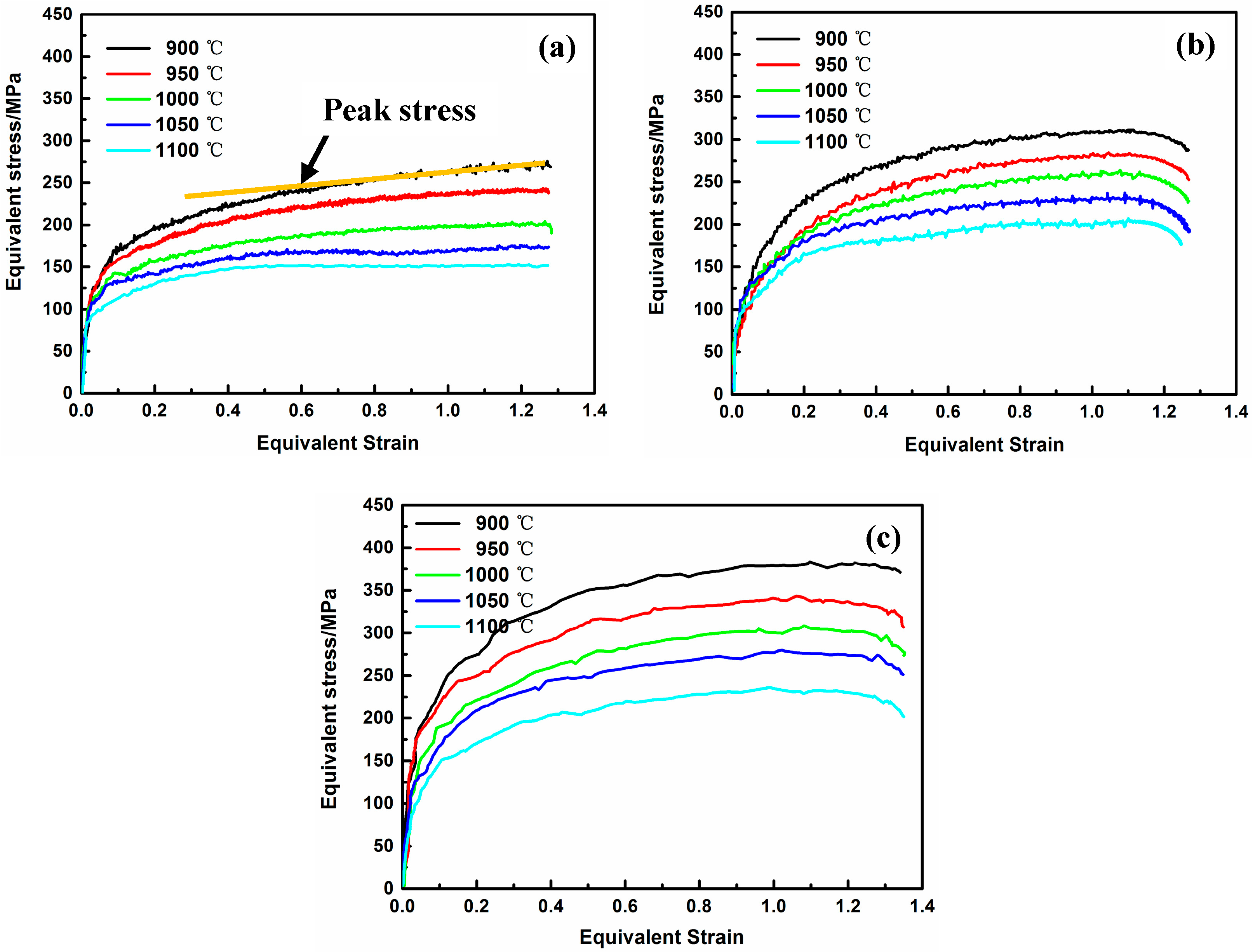
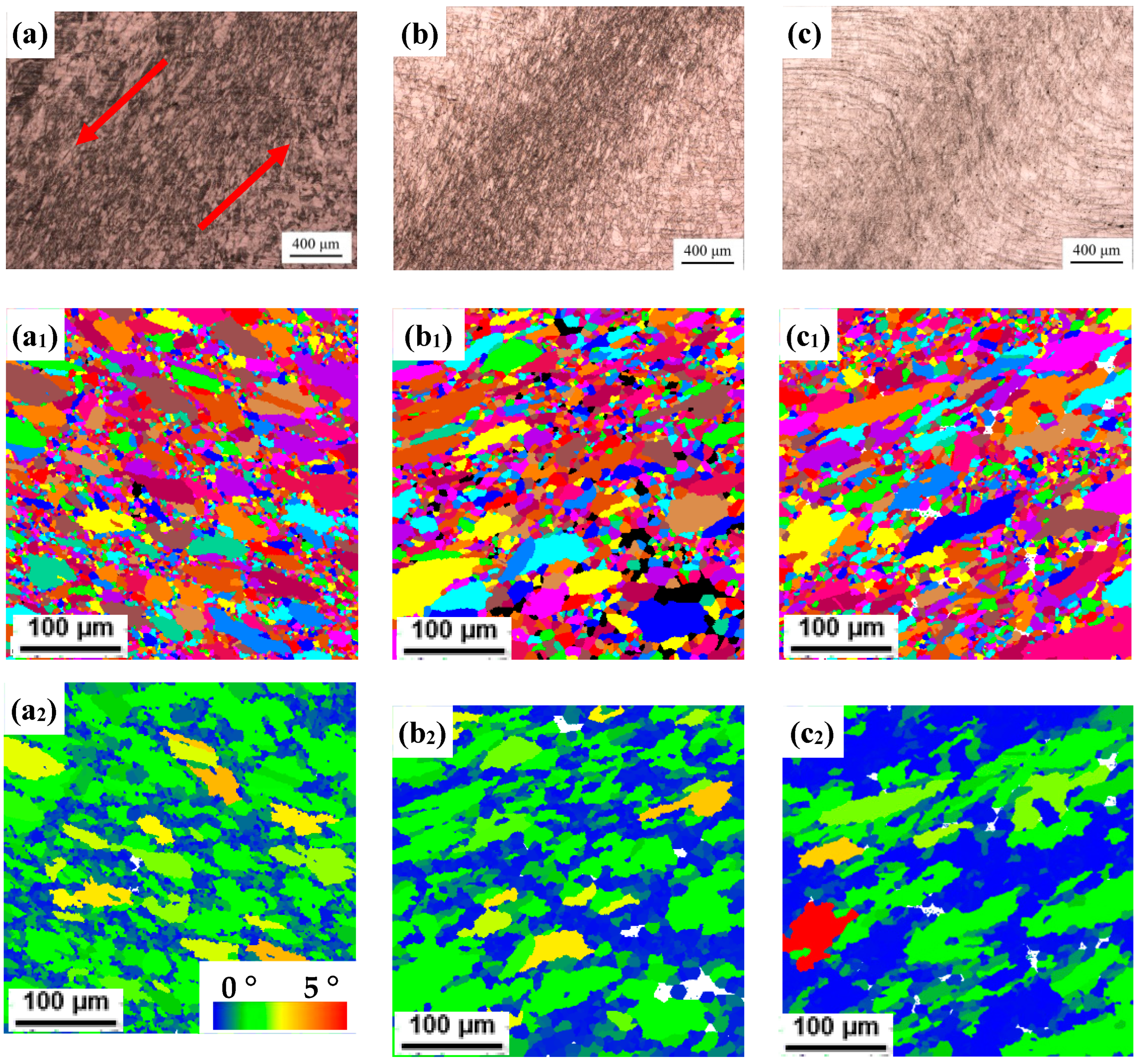
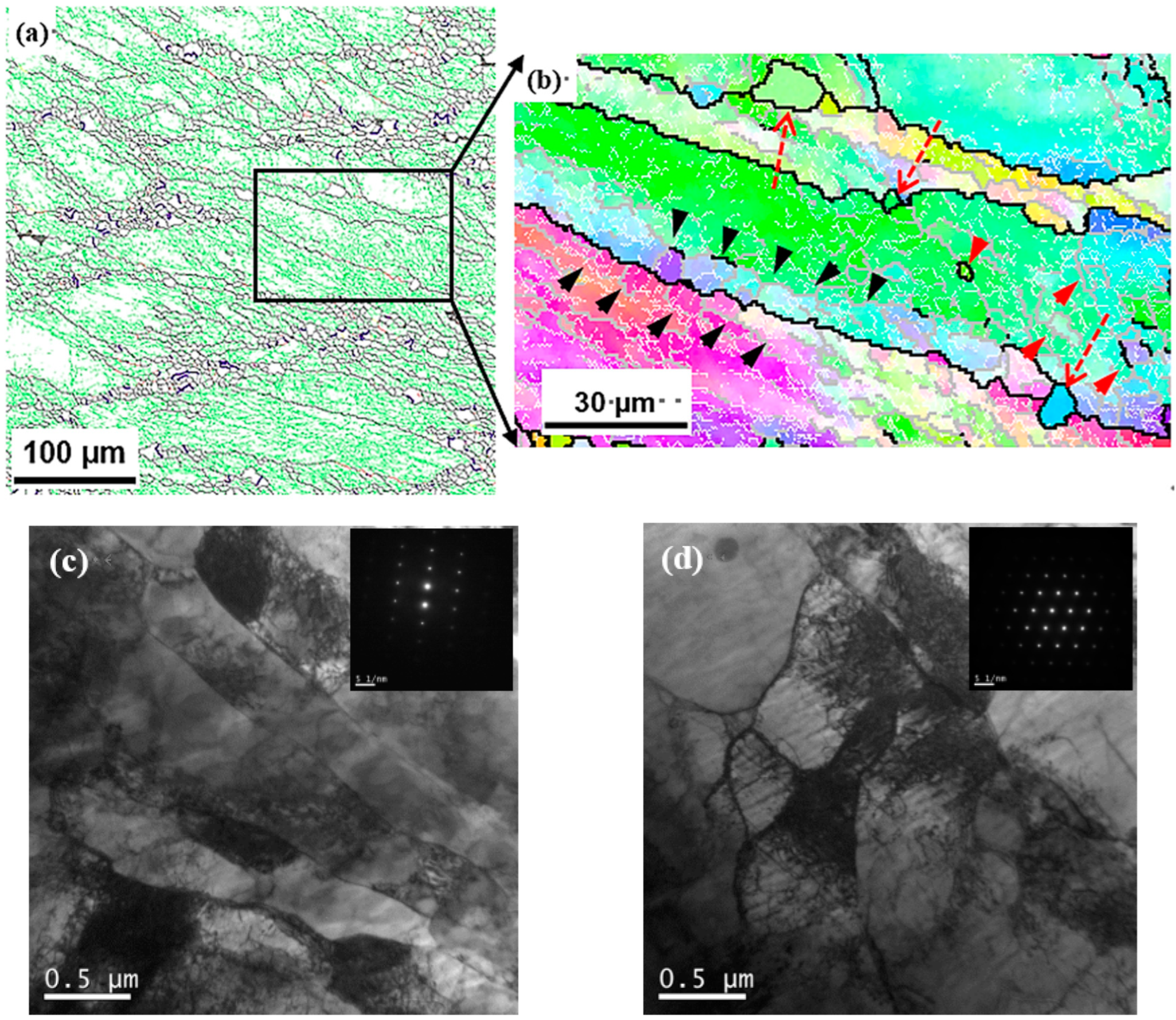
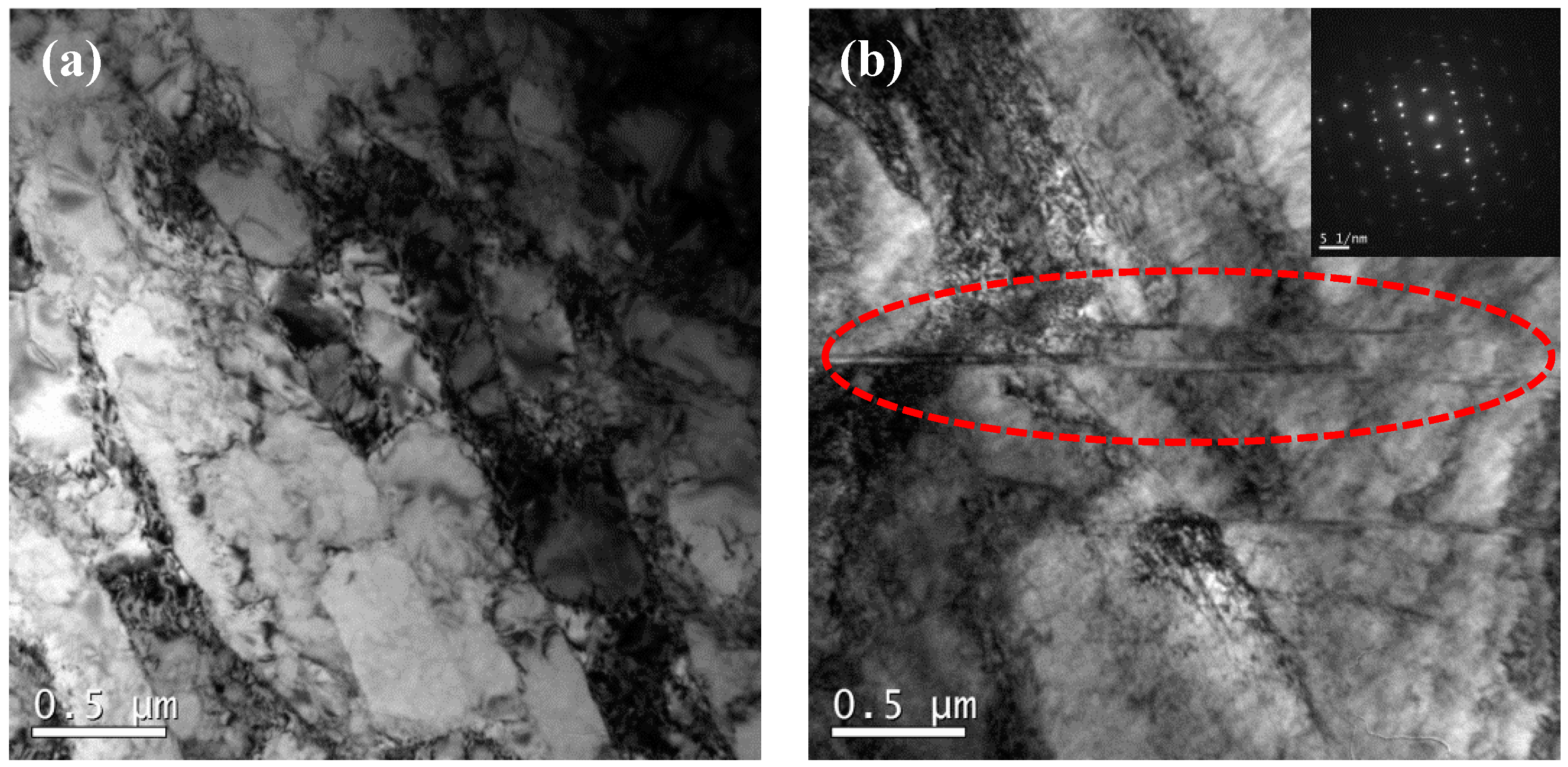
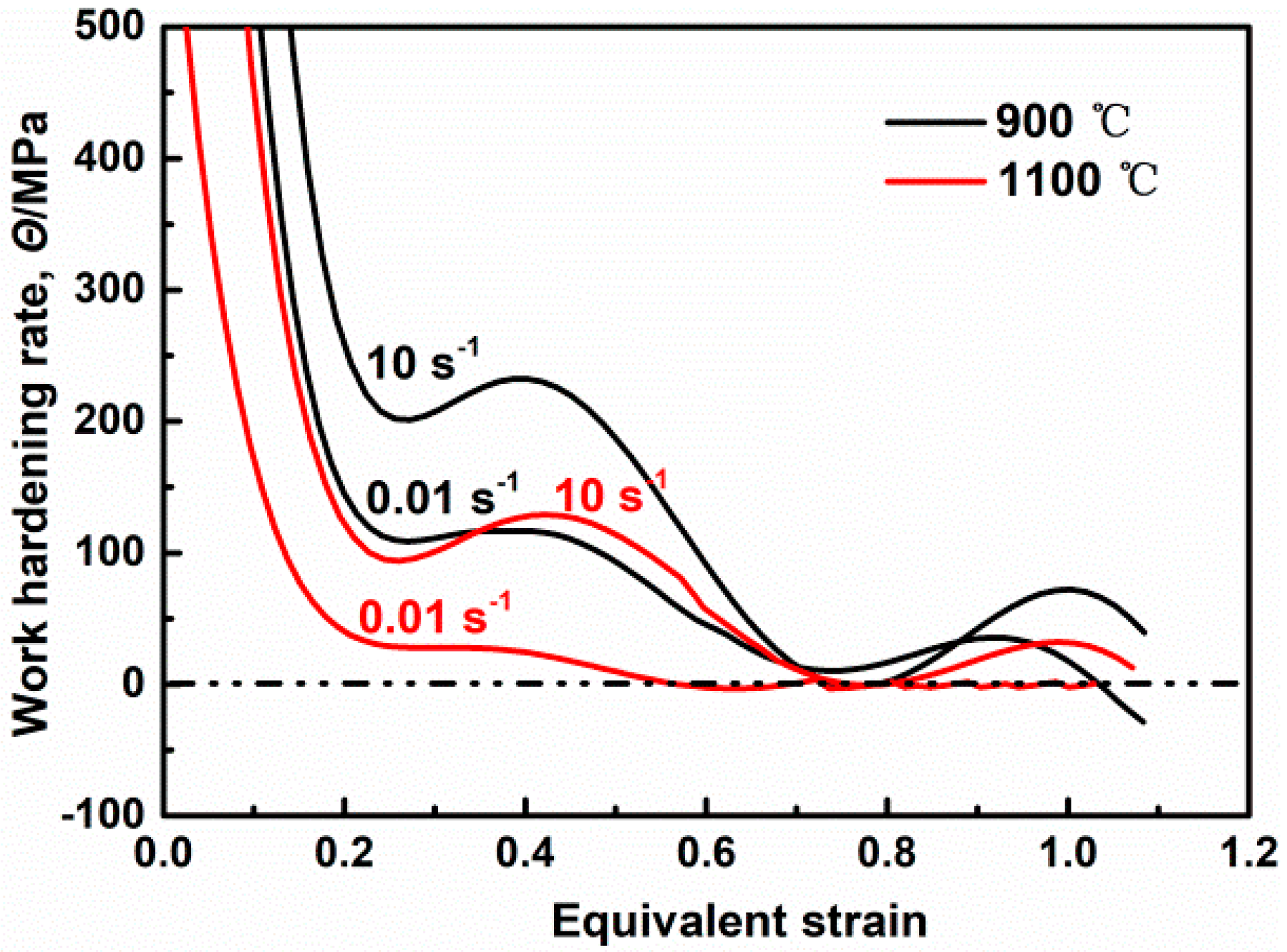

| Deformation Condition | Equivalent Strain | ||
|---|---|---|---|
| 0.3 | 0.6 | 0.9 | |
| 950 °C, 1 s−1 | 5.80 | 10.44 | 5.05 |
| 1100 °C, 10 s−1 | <0 | 1.79 | <0 |
Disclaimer/Publisher’s Note: The statements, opinions and data contained in all publications are solely those of the individual author(s) and contributor(s) and not of MDPI and/or the editor(s). MDPI and/or the editor(s) disclaim responsibility for any injury to people or property resulting from any ideas, methods, instructions or products referred to in the content. |
© 2024 by the authors. Licensee MDPI, Basel, Switzerland. This article is an open access article distributed under the terms and conditions of the Creative Commons Attribution (CC BY) license (https://creativecommons.org/licenses/by/4.0/).
Share and Cite
Sang, D.; Xin, X.; Zhai, Z.; Fu, R.; Li, Y.; Jing, L. Effect of High-Temperature Deformation Twinning on the Work Hardening Behavior of Fe-38Mn Alloy during Hot Shear-Compression Deformation. Materials 2024, 17, 3641. https://doi.org/10.3390/ma17153641
Sang D, Xin X, Zhai Z, Fu R, Li Y, Jing L. Effect of High-Temperature Deformation Twinning on the Work Hardening Behavior of Fe-38Mn Alloy during Hot Shear-Compression Deformation. Materials. 2024; 17(15):3641. https://doi.org/10.3390/ma17153641
Chicago/Turabian StyleSang, Deli, Xiaoli Xin, Zikang Zhai, Ruidong Fu, Yijun Li, and Lei Jing. 2024. "Effect of High-Temperature Deformation Twinning on the Work Hardening Behavior of Fe-38Mn Alloy during Hot Shear-Compression Deformation" Materials 17, no. 15: 3641. https://doi.org/10.3390/ma17153641





